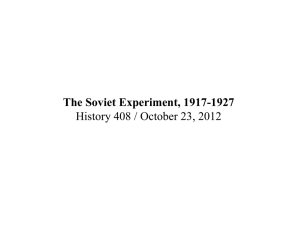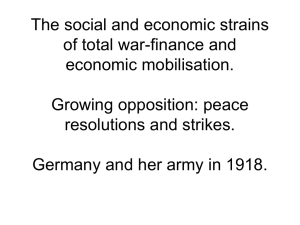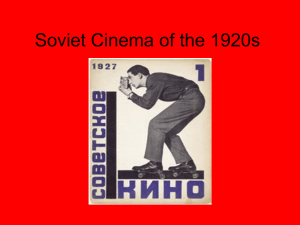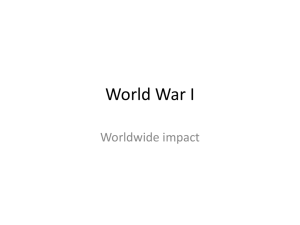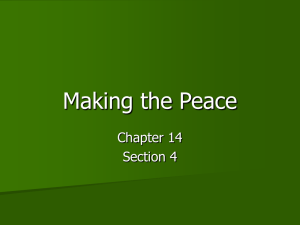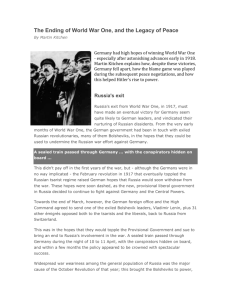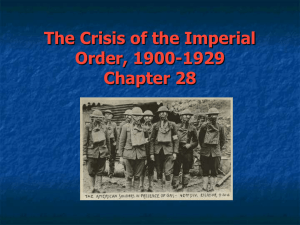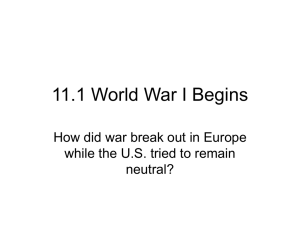chapter 22 - Hamburg Central School District
advertisement
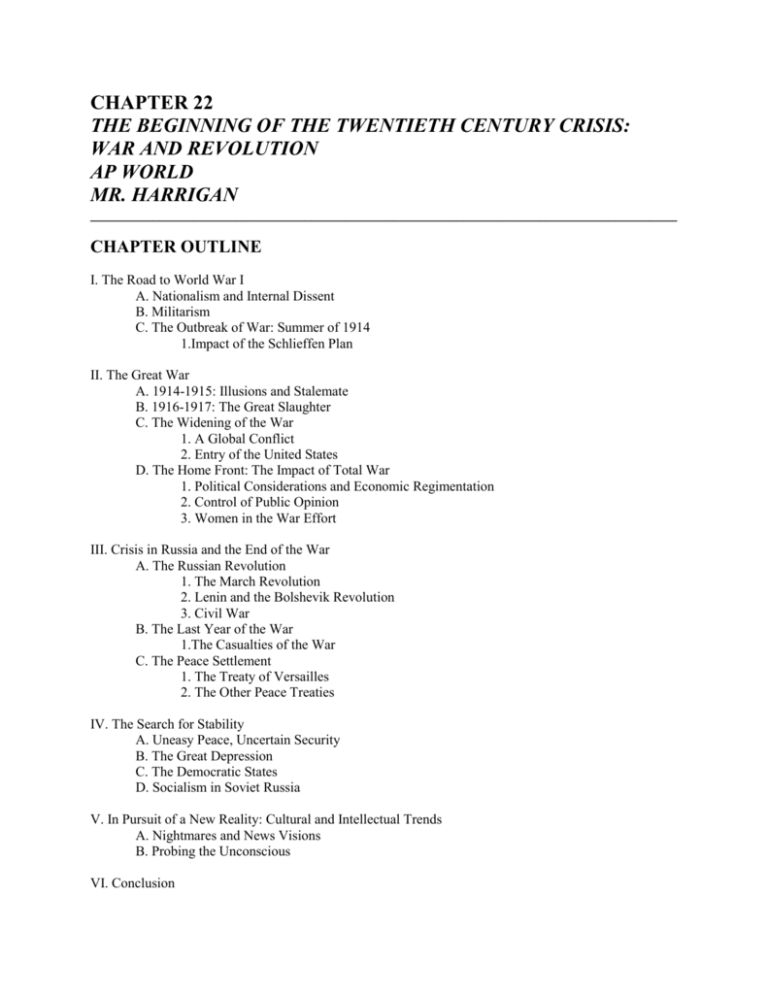
CHAPTER 22 THE BEGINNING OF THE TWENTIETH CENTURY CRISIS: WAR AND REVOLUTION AP WORLD MR. HARRIGAN _____________________________________________________________________________________ CHAPTER OUTLINE I. The Road to World War I A. Nationalism and Internal Dissent B. Militarism C. The Outbreak of War: Summer of 1914 1.Impact of the Schlieffen Plan II. The Great War A. 1914-1915: Illusions and Stalemate B. 1916-1917: The Great Slaughter C. The Widening of the War 1. A Global Conflict 2. Entry of the United States D. The Home Front: The Impact of Total War 1. Political Considerations and Economic Regimentation 2. Control of Public Opinion 3. Women in the War Effort III. Crisis in Russia and the End of the War A. The Russian Revolution 1. The March Revolution 2. Lenin and the Bolshevik Revolution 3. Civil War B. The Last Year of the War 1.The Casualties of the War C. The Peace Settlement 1. The Treaty of Versailles 2. The Other Peace Treaties IV. The Search for Stability A. Uneasy Peace, Uncertain Security B. The Great Depression C. The Democratic States D. Socialism in Soviet Russia V. In Pursuit of a New Reality: Cultural and Intellectual Trends A. Nightmares and News Visions B. Probing the Unconscious VI. Conclusion IDENTIFICATIONS 1. Archduke Francis Ferdinand 2. alliance system 3. conscription 4. militarism 5. Serbia and the Black Hand 6. the Schlieffen Plan 7. First Battle of the Marne 8. Battles of Tannenberg and Masurian Lakes 9. trench warfare and “no man’s land” 10. the Somme and Verdun 11. Gallipoli 12. Lawrence of Arabia 13. Togoland, Cameroons, South West Africa, and German East Africa 14. Erich Maria Remarque’s All Quiet on the West Front 15. “total war” 16. the Lusitania 17. unrestricted submarine warfare 18. Woodrow Wilson 19. Defense of the Realm Act (DORA) 20. women and the right to vote 21. Czar Nicholas II 22. Rasputin 23. March 1917 revolution 24. International Women’s Day, March 8, 1917 25. Alexander Kerensky and the Provisional Government 26. V.I. Lenin and the Bolsheviks 27. the “sealed train” 28. “Peace, Land, and Bread” and “All Power to the Soviets” 29. November 1917 revolution 30. Treaty of Brest Litovsk 31. Reds v. Whites 32. Leon Trotsky 33. “war commuism” 34. the Cheka 35. Second Battle of the Marne 36. November 11, 1918 37. Armenian genocide 38. Paris Peace Conference 39. Georges Clemenceau 40. David Lloyd George 41. Wilson’s League of Nations 42. Treaty of Versailles 43. Article 231, war guilt clause and reparations 44. a “dictated peace” 45. Finland, Latvia, Estonia, Lithuania, Poland, Czechoslovakia, Austria, Hungary, Yugoslavia 46. Ottoman Empire 47. League Nations mandates 48. runaway inflation and the Ruhr 49. Gustav Stresemann and Aristide Briand 50. Dawes Plan 51. Treaty of Locarno 52. the October 1929 Stock Market Crash 53. Great Depression 54. bread lines 55. John Maynard Keynes and deficit spending 56. France’s Popular Front 57. the Weimar Republic 58. Franklin Delano Roosevelt and the New Deal 59. Works Progress Administration and the Social Security Act 60. the Soviet’s New Economic Policy (NEP) 61. Leon Trotsky v. Joseph Stalin, “Comrade Index-Card” 62. short skirts and short hair 63. Theodor van de Velde’s Ideal Marriage 64. Dadaism and Hannah Hoch 65. Surrealism and Salvador Dali 66. Salvador Dali 67. “stream of consciousness” 68. Herman Hesse 69. James Joyce’s Ulysses 70. Hollywood studio system 71. Marlene Dietrich and The Blue Angel ANSWER: b (p. 510) TRUE-FALSE QUESTIONS 1. After the Great War finally concluded in 1918, most people believed that with peace restored, pre-war progress would readily continue. False (pages 491, 510) 2. At the first Battle of the Marne, French troops were driven back and German forces occupied Paris. False (p. 493) 3. In ten months at Verdun, 700,000 men lost their lives for only a few miles of terrain. True (p. 494) 4. Lawrence of Arabia led the Ottoman Empire to victory at the Battle of Gallipoli. False (p. 495) 5. It was the decision of the German government to return to unrestricted submarine warfare that brought the United States into World War I in 1917. True (p. 497) 6. Because of post-war economic growth, the great majority of women retained their jobs after World War I. False (p. 499) 7.Among the other civilian casualties in World War I were one million Armenians in the Ottoman Empire, the victims of genocide. True (p. 503) 8. In the Great Depression, most democratic governments followed the classical liberal remedy by lowering wages and raising tariffs. True (p. 506) 9. By the end of the civil war in 1921, the Soviet economy had recovered to 90 percent of its 1913 levels. False (p. 508) 10. Because of the massive destruction caused by World War I, mass forms of communication declined in the 1920s. False (p. 510) _____________________________________________________________________________________ CHAPTER OUTLINE I. The Road to World War I 313 A. Nationalism and Internal Dissent B. Militarism C. The Outbreak of War: Summer of 1914 1.Impact of the Schlieffen Plan II. The Great War A. 1914-1915: Illusions and Stalemate B. 1916-1917: The Great Slaughter C. The Widening of the War 1. A Global Conflict 2. Entry of the United States D. The Home Front: The Impact of Total War 1. Political Considerations and Economic Regimentation 2. Control of Public Opinion 3. Women in the War Effort III. Crisis in Russia and the End of the War A. The Russian Revolution 1. The March Revolution 2. Lenin and the Bolshevik Revolution 3. Civil War B. The Last Year of the War 1.The Casualties of the War C. The Peace Settlement 1. The Treaty of Versailles 2. The Other Peace Treaties IV. The Search for Stability A. Uneasy Peace, Uncertain Security B. The Great Depression C. The Democratic States D. Socialism in Soviet Russia V. In Pursuit of a New Reality: Cultural and Intellectual Trends A. Nightmares and News Visions B. Probing the Unconscious VI. Conclusion POSSIBLE CLASS LECTURE/DISCUSSION TOPICS 1. Trace and assess the major trends which converged to initiate the “Great War,” distinguishing between long and short-range factors and different ways they have been linked to explain the war’s inception. 2. Examine the particular blend of naiveté and incompetence which saw governments able to devise new means to increase military numbers and control popular thinking while military leaders continued to employ discredited tactics long after their failure was patently clear. 3. Probe how, and why, millions of troops, aside from those in Russia, contained their doubts about the massive casualties and failed strategies of military leaders and continued to fulfill their duties for four long, deadly years. 4. Trace the revolutionary ideologies, movements, and events in Imperial Russia from the early nineteenth century to the beginning of 1917. 5. Examine the evolution of the Russian Revolution from the Petrograd protests through the end of the 314 Civil War, juxtaposing the impact of social and economic conditions against the roles of Kerensky, Lenin, Trotsky, and others, and of the Red and White military forces. 6. Analyze the mélange of interests which became focused on the Paris Peace Conference and determined the nature of its operation and results in spite of the hopes of individuals like Woodrow Wilson. 7. Analyze the successes and failures of the Weimar Republic from 1919 to its demise in 1933 in the context of the coming to power of Adolph Hitler. 8. Assess the content of the major events of the interwar period in Europe, and elsewhere, noting not only the intra-European developments but also the impact of the policies of the United States and the Soviet Union on the capacity to deal with evolving problems. 9. Examine the obstacles the western democracies faced in preserving their World War I victory during the interwar years. 10. Trace the nature and impact of Western attempts to understand and deal with the postwar world, as revealed by efforts to insure peace, manage economic crises, and get beyond the superficial elements of the “flapper age” and the visions of Dadaism and Surrealism. THOUGHT/DISCUSSION QUESTIONS FOR THE PRIMARY SOURCES (BOXED DOCUMENTS) 1. “The Excitement of War”—Why did the outbreak of war in 1914 result in such an enthusiastic response, individually and collectively? Is Zweig’s comment that too long a period of peace had given the populace of Europe a romantic and naive view of war? Why or why not? Why was war so fundamentally misunderstood, not only by “average” people, but also by their leaders? (page 495) 2. The Reality of War: Trench Warfare”— Why did the rats, the seemingly unending series of attacks, and the deaths continue for so many years? Were the soldiers so dehumanized that they responded like factory and mine workers during the early stages of the First Industrial Revolution? Why or why not? Why did the soldiers of the various armies continue to accept such conditions instead of mutinying or rebelling? Would Dadaism have seemed reasonable to such soldiers? (p. 496) 3. “Soldier and Peasant Voices”— What are the specific complaints the Leningrad soldier and the peasant makes against the Bolshviks? How are they similar and how are they different? Do they both see conspiracy and foreign influences at work? Given the date (January 1918), are those criticisms justified? Why or why not? How might Lenin and the Bolshevik leadership respond to these two letters? (p. 501) 4. “The Great Depression: Unemployed and Homeless in Germany”—What does this passage reveal about the scale and intensity of the Depression’s impact in Germany? Do the allusions to homeless families, prison behavior and feeding animals augur well for the future of the Weimar Republic? Would authoritarian extremists like Hitler be likely to attract the people he describes? Why or why not? (p. 507) STUDENT PROJECT OPTIONS 1. Have students sample some of the excited “average person” responses to the onset of World War I 315 and some of the government propaganda materials of the wartime period with the goal of determining the bases and duration of the initial excitement and how necessary the “information” (propaganda) campaigns really were. Their conclusions may well vary widely and provide material for a lively debate or less formal discussion. 2. Ask students to study the strategies employed by the combatant forces in the Great War, and their results. Personal reminiscences of participants can be extremely informative. 3. Invite students to study the breakdown of the tsarist system in Russia and ask them to then compare that process with some of the different responses to wartime stresses in other countries. Ask them to speculate on the possibility of a similar situation in either Germany or France if the stalemated war had lasted another two years. 4. Have students probe major issues facing the Paris Peace Conference and then, after dividing into major power “teams,” hold a “model Versailles Conference” (perhaps at the “Big Three/Four” level) to try to work out agreements on the major issues studied. At the least, it will enable them to confront the complexity of “high diplomacy.” 5. Ask students to study the German reparations and inflation crisis of 1923 and the resultant problems and turmoil, focusing particularly on the depth of the emotions aroused by the French occupation of the Ruhr. 6. Invite students to research the impact of the Great Depression on European society and then assess its relative impact on the United States, examining in particular the changes it brought to the lives of working and middle class groups. Have them look particularly at Germany, which was hit less than a decade after Germany’s 1923 economic crisis. 7. Have students consider why Dadaism, Surrealism, and “the unconscious” were seemed to be apt depictions of reality to so many in the Western world in the early twentieth century. ESSAYS/STUDENT PAPER TOPIC QUESTIONS 1. Was the political and military leaders’ incapacity, mass naiveté, or nationalism the most important factor in explaining the onset of World War I? Why that one, and not the other two? 2. How and why did the events of the late spring and summer of 1914 ultimately move beyond the ability of governmental leaders to control? 3. Considering the possible causes and events, was World War I inevitable? Why or why not? If inevitable, from what date or from what event was there no turning back? 4. What were the failures of the first two years of World War I, and how were they “improved upon” in 1917 and 1918? 5. Why was Russia the only major belligerent power to experience a revolution and a successful coup d’etat during the war? Was the collapse of the imperial government in Germany at all similar? Why or why not? 6. Were the Russian Revolutions of 1917 inevitable? Why or why not? 316 7. How, and why, did World War I end as, and when, it did? Did the “winners” really “win”? Why or why not? 8. Did the Allied and Associated leaders at the Paris Peace Conference develop a true peace treaty, or a politically distorted document likely to initiate future conflict? What role did Germany have at the gathering? Why, in each instance? 9. How did the results of the Peace Conference create problems in postwar Europe? For whom, in particular? Could these problems have been dealt with more effectively? If so, how? 10. “The failures of the Weimar Republic guaranteed the rise to power of Adolph Hitler.” Discuss, pro and con. 11. Discuss the causes and major results of the Great Depression in the United States and Europe. Was it also a part of the Great War’s aftermath? Was it effectively over by 1938? 12. Was Lenin’s initiation of the NEP an exercise in “closet capitalism” equivalent to Europe’s crisis-based acceptance of increased governmental authority during the “Great War,” or a “sellout” of socialism? Show how and why you think as you do. 13. How did the democratic regimes of Britain, France and the United States avoid totalitarian takeovers \ while the Weimar Republic was unable to? 14. Is it accurate to say that World War I irrevocably transformed the world by permanently altering earlier ways of thought and action? Show why or why not, giving specific examples. 15. “World War I fundamentally and permanently changed the lives of women in western civilization.” Discuss. IDENTIFICATIONS 1. Archduke Francis Ferdinand 2. alliance system 3. conscription 4. militarism 5. Serbia and the Black Hand 6. the Schlieffen Plan 7. First Battle of the Marne 8. Battles of Tannenberg and Masurian Lakes 9. trench warfare and “no man’s land” 10. the Somme and Verdun 11. Gallipoli 12. Lawrence of Arabia 13. Togoland, Cameroons, South West Africa, and German East Africa 14. Erich Maria Remarque’s All Quiet on the West Front 15. “total war” 16. the Lusitania 17. unrestricted submarine warfare 317 18. Woodrow Wilson 19. Defense of the Realm Act (DORA) 20. women and the right to vote 21. Czar Nicholas II 22. Rasputin 23. March 1917 revolution 24. International Women’s Day, March 8, 1917 25. Alexander Kerensky and the Provisional Government 26. V.I. Lenin and the Bolsheviks 27. the “sealed train” 28. “Peace, Land, and Bread” and “All Power to the Soviets” 29. November 1917 revolution 30. Treaty of Brest Litovsk 31. Reds v. Whites 32. Leon Trotsky 33. “war commuism” 34. the Cheka 35. Second Battle of the Marne 36. November 11, 1918 37. Armenian genocide 38. Paris Peace Conference 39. Georges Clemenceau 40. David Lloyd George 41. Wilson’s League of Nations 42. Treaty of Versailles 43. Article 231, war guilt clause and reparations 44. a “dictated peace” 45. Finland, Latvia, Estonia, Lithuania, Poland, Czechoslovakia, Austria, Hungary, Yugoslavia 46. Ottoman Empire 47. League Nations mandates 48. runaway inflation and the Ruhr 49. Gustav Stresemann and Aristide Briand 50. Dawes Plan 51. Treaty of Locarno 52. the October 1929 Stock Market Crash 53. Great Depression 54. bread lines 55. John Maynard Keynes and deficit spending 56. France’s Popular Front 57. the Weimar Republic 58. Franklin Delano Roosevelt and the New Deal 59. Works Progress Administration and the Social Security Act 60. the Soviet’s New Economic Policy (NEP) 61. Leon Trotsky v. Joseph Stalin, “Comrade Index-Card” 62. short skirts and short hair 63. Theodor van de Velde’s Ideal Marriage 64. Dadaism and Hannah Hoch 65. Surrealism and Salvador Dali 66. Salvador Dali 67. “stream of consciousness” 68. Herman Hesse 318 69. James Joyce’s Ulysses 70. Hollywood studio system 71. Marlene Dietrich and The Blue Angel MULTIPLE CHOICE QUESTIONS 1. The Battle of the Somme a. was the first major battle of World War I. b. killed more than 21,000 British soldiers in a single day. c. was the first, quite unexpected, victory of the Austro-Hungarian army. d. occurred in Belgium, and brought Britain and the Netherlands into the war. e. was fought near the beaches of Gallipoli. ANSWER: b (page 490) 2. On June 28, 1914, the Archduke Francis Ferdinand, heir to the Austrian throne, was assassinated in the Bosnian city of a. Trieste. b. Prague. c. Belgrade. d. Sarajevo. e. Mostar. ANSWER: d (p. 491) 3. Among the major factors leading to the outbreak of war in mid-1914 was a. badly implemented brinkmanship on the part of Europe’s diplomats. b. German leaders’ determination to end Danish opposition to construction of a huge naval base at Kiel. c. Japan’s determination to seize either United States or German colonies in the Pacific, leading to the Japanese declaration of war against Germany in mid-August 1914. d. Russia’s unexpected attack on Serbia and Bulgaria in late June 1914. e. the assassination of the heir to the Russian Empire. ANSWER: a (p. 492) 4. As a result of the assassination the Archduke on June 28, 1914, a. Germany invaded France on June 29. b. Serbia declared war on Austria on July 1. c. Russia mobilized its army on July 29. d. France declared war on Germany on July 1. e. Britain declared war on Germany on July 4. ANSWER: c (p. 492) 5. Using the Schlieffen Plan, a. Germany launched a massive invasion of the Warsaw region of Poland. b. France declared war on Austria. c. Germany invaded France by way of Belgium. 319 d. England declared war on Belgium. e. Italy invaded the Austrian Tyrol. ANSWER: c (pp. 492-493) 6. The general attitude toward the prospect of a Europe-wide war among the people of Europe in the summer of 1914 was one of a. fear of the prospect of going to war. b. naively romantic enthusiasm for the adventure of war. c. lack of enthusiasm for the confrontation ahead. d. indifference to developments in international affairs as spring faded into summer. e. ignorance, because no one knew what the diplomats were doing behind closed doors. ANSWER: b (p. 493) 7. All of the following developments occurred during the first year of World War I except a. the Schlieffen Plan almost gave Germany victory in the West. b. the Western Front became a bloody stalemate involving virtually endless trench warfare. c. Russia defeated the Germans at the Battles of Tannenberg and Masurian Lakes. d. a combined German-Austrian force dealt the Russians a nearly fatal defeat in Galicia. e. the Serbians were defeated by a combined German-Austrian-Hungarian force. ANSWER: c (p. 493) 8. In a failed effort to open a Balkan front, the British launched an attack on a. Belgium. b. Constantinople. c. Adrianople. d. Gallipoli. e. Sarajevo. ANSWER: d (p. 495) 9. Among the major illusions held by civilians and military leaders early in World War I was a. the belief that it would never be over. b. that the Americans would enter the war in order to insure a quick victory. c. the belief of most military leaders that the use of still larger numbers of troops would allow them to get their troops beyond the enemy trenches and gain a quick victory. d. poison gas would end the war by Christmas. e. a revolution in Germany would force Germany out of the war. ANSWER: c (p. 493) 10. By 1917, World War I had a. caused the deaths of millions. b. enveloped every nation of the world in warfare. c. resulted in the German capture of several British and French colonies. d. produced a German attack on United States seaports. e. led to a communist revolution in Germany. ANSWER: a (pp. 493, 502) 11. All of the following took place in the nations of Europe during World War I except a. Italy finally joined the Central Powers in early 1918. b. Russia ended its role in the war in the spring of 1918. c. government repression of civil liberties greatly increased. 320 d. employment opportunities for women increased enormously. e. the loss of enormous number of soldiers. ANSWER: a (pp. 498-499, 502) 12. The final German offensive was stopped on July 18, 1918 at the a. Masurian Lakes. b. Second Battle of the Marne. c. Battle of Verdun. d. Battle of Argonne Forest. e. Battle of the Somme. ANSWER: b (p. 502) 13. The troops of which country turned the tide of the war in 1918? a. Japan b. the United States c. China d. Abyssinia e. Spain ANSWER: b (p. 502) 14. The United States a. entered the war immediately after a number of Americans died when the Lusitania was sunk by a German submarine. b. had, in President Wilson, a strong foe of the practice of total war mobilization. c. sent its troops to China during the civil war there. d. took an idealistic stance at the Paris Peace Conference. e. joined the League of Nations in spite of Woodrow Wilson’s opposition. ANSWER: d (p. 503) 15. The British government a. sharply limited free speech when it implemented the Defense of the Realm Act. b. opposed the use of poison gas under any and all circumstances. c. developed a program that employed over 1.3 million children, even in positions formerly beyond their previously presumed “capacity.” d. brought William Gladstone back as Prime Minister when Lloyd George was defeated. e. seized Constantinople from the Ottomans. ANSWER: a (p. 498) 16. The Siberian peasant who had great influence on the Russian tsarina was a. Pugachev. b. Alexandra. c. Nicholas. d. Rasputin. e. Alexander. ANSWER: d (p. 499) 17. Tsar Nicholas II abdicated his throne as a result of strikes that broke out a. in Moscow in late 1918. b. after working class women staged a massive food march in Petrograd. c. in Warsaw after the 1916 crop failure. 321 d. after the Memorial Day Massacre of steel workers. e. after the police murdered a Socialist Revolutionary leader in the Winter Palace. ANSWER: b (p. 499) 18. The Provisional Government that took power after the tsar abdicated was headed by a. Mustafa Kemal. b. Joseph Stalin. c. Alexander Kerensky. d. V. I. Lenin. e. Leon Trotsky. ANSWER: c (p. 499) 19. The soviets were a. composed entirely of Bolsheviks. b. made up of the conservative factions of the middle classes. c. councils of workers’ and soldiers’ deputies. d. primarily composed of disgruntled civil servants. e. composed only of peasants. ANSWER: c (p. 500) 20. In Russia during the Great War a. the military and political leaders were generally competent and efficient. b. the tsar permitted Rasputin to intrude into policy making. c. the Bolsheviks urged that Russia renew its war effort while promising land for all. d. Czar Nicholas II was murdered. e. Siberia declared its independence. ANSWER: b (p. 499) 21. In early November 1917, Lenin’s Bolsheviks a. staged the Sverdlovsk Massacre in Kiev. b. killed the tsar. c. successfully took power from the Provisional Government in a coup. d. established the White army. e. created the Council of Soviets. ANSWER: c (p. 500) 22. In 1918 Lenin signed the Treaty of Brest-Litovsk, in which Russia gave up all of the following except a. the Baltic states. b. eastern Poland. c. Finland. d. the Ukraine. e. Muscovy. ANSWER: e (p. 502) 23. Leon Trotsky a. had been a professor in Britain from 1908 to 1913. b. had served as Kerensky’s secret police leader until he defected to the Mensheviks. c. led the Fourth International in Brussels. 322 d. became premier of the Soviet Union after Stalin’s death. e. led the Left group in the Politburo after Lenin’s death. ANSWER: e (p. 508) 24. Lenin’s new secret police were known as the a. KGB. b. Cheka. c. NKVD. d. Gestapo. e. Savak. ANSWER: b (p. 502) 25. Under Lenin’s New Economic Policy, a. Lenin retired from active political life. b. state requisitions of peasant grain continued. c. individuals were permitted to own small retail stores and peasants to sell their produce. d. the state relinquished control over all heavy industrial operations. e. banks and mines became privately-owned. ANSWER: c (p. 508) 26. After Lenin’s death, a. Trotsky replaced him and gradually scaled down the NEP over a five-year period. b. the Socialist Revolutionary party seized power and held it until 1931. c. Stalin was assassinated by the followers of Trotsky, who believed that “Comrade Card-Index” was planning to murder all of his political rivals. d. the Politburo split into a Left group, which wanted to sacrifice the interests of the peasant majority in the pursuit of rapid industrialization and world revolution, and a Right group, which wished to construct a socialist state in Russia. e. Kalashnikov became party general secretary. ANSWER: d (p. 508) 27. During the Russian Civil War a. the White armies almost captured the country, but proved unable to develop unified political plans or adequately coordinate military activities. b. Rasputin proved to be an effective war commissar. c. the Red Terror was designed to kill all Bolshevik supporters. d. the Whites captured Moscow but were forced to relinquish it by the Allies. e. Nicholas II and his family escaped to Great Britain. ANSWER: a (p. 502) 28. The British prime minister who had won a decisive electoral victory on a platform committed to making the Germans pay for the war was a. Georges Clemenceau. b. David Lloyd George. c. Neville Chamberlain. d. Woodrow Wilson. e. Winston Churchill. ANSWER: b (p. 503) 29. The Versailles Treaty a. gave sovereignty in the Ruhr to Belgium. b. granted Syria, Jordan and Iraq full independence. 323 c. established a League of Nations, the agency ardently desired by President Wilson. d. established the United Nations, ardently desired by Winston Churchill. e. ended the civil war in Russia. ANSWER: c (p. 503) 30. The Germans disliked the Versailles Treaty because a. it required them to give up Berlin and Bavaria. b. Article 231 said that Germany and Austria bore sole responsibility for starting the war. c. they saw its “armistice clause” as an encroachment on their national sovereignty. d. they were forced to join the League of Nations. e. it guaranteed no more war. ANSWER: b (p. 490) 31. Which of the following was not a penalty imposed on Germany in the Versailles Treaty? a. the transfer of Bavaria to France as a reparations payment b. a reduction in its army to 100,000 men c. a reduction in its navy d. the demilitarization of all lands along the Rhine e. the return of Alsace and Lorraine to France and the cession of parts of Prussia to Poland ANSWER: a (p. 503) 32. Which of the following nations were created by the 1919 Paris Peace Conference? a. Paraguay and Pakistan b. Pakistan and Bulgaria c. Czechoslovakia and Poland d. Serbia and Greece. e. Finland and Bulgaria. ANSWER: c (p. 503) 33. The new concept of the “mandate,” created at the Paris Peace Conference, a. was a means by which non-Western nations could achieve colonial status. b. was a device for giving a nation the right to administer another nation on behalf of the United Nations. c. actually expanded Western imperialism in former Ottoman areas. d. gave the United States control over the Philippines. e. turned over parts of Germany to France as reparations for the war. ANSWER: c (pp. 504-505) 34. Which of the following is an accurate description of Middle Eastern mandates instituted after World War I? a. Belgium took Anatolia and the Hejaz. b. France took control of Iraq and Palestine. c. Greece took control of Turkey. d. Britain took control of Iraq and Palestine. d. Italy took control of Egypt and Kuwait. ANSWER: d (p. 504) 35. In retrospect, it is clear that the First World War a. accustomed political leaders to see a governmental role in coordinating economic activity as both vital and, increasingly, normal in meeting economic goals—but not in capitalist 324 regimes. b. helped to create the new military thinking of early 1916 which enabled military commanders on the Western Front to cut casualties and equipment usage while ending the debilitating system of trench warfare. c. profoundly revived the faith of most soldiers, and civilians also, in the possibility of ending war and fostering permanent peace. d. helped to produce structural crises which toppled the Russian, Ottoman, Austro-Hungarian and German governments. e. made the world safe for democracy. ANSWER: d (p. 503) 36. Which of the following was a manifestation of American isolationism? a. failure of the United States to participate in the Great War b. failure of the United States to join the League of Nations c. failure of President Wilson to take part in the peace treaty deliberations in 1919 d. the American Neutrality Treaty with Germany and the Soviet Union e. the election of Woodrow Wilson ANSWER: b (p. 505) 37. The crisis stemming from German non-payment of its 1922 reparations installment a. caused Britain to send troops into the Ruhr to collect the payments in kind. b. led to severe hyperinflation, as Germany’s “passive resistance” made the mark worthless. c. led the Soviet Union to annex Upper Siberia in lieu of “reparations due.” d. resulted in a successful Bolshevik revolution in Germany. e. led to the invasion of Poland by the German army. ANSWER: b (p. 505) 38. The Dawes Plan was all of the following except it a. was developed after the massive inflation of 1923. b. served as a mechanism for the reduction and stabilization of German war reparations. c. provided Germany with a $200 million recovery loan. d. ultimately resulted in American investments in Europe that produced a period of prosperity there in the 1920s. e. permanently solved all of Germany’s economic problems. ANSWER: e (p. 505) 39. The Treaty of Locarno a. guaranteed the new German borders with Poland and Czechoslovakia in the east.. b. guaranteed the new German borders with Belgium and France in the west. c. achieved significant disarmament in Europe for the first time in seventy-five years. d. allowed the Soviet Union to join the League of Nations. e. was a secret military alliance between Germany and the Soviet Union. ANSWER: b (p. 505) 40. The postwar diplomacy of the 1920s a. was epitomized by the active role the United States played in making sure that European policies were sensible and restrained. b. showed that the “lessons” of the Great War, especially the need for true justice in international 325 affairs, had been thoroughly learned, as in the case of the awarding of mandates in Iraq and Syria to the United States. c. was generally superficial, as reflected by the overly optimistic response to the Locarno Treaty and other agreements but which was unable to deal the issue of military disarmament. d. was unusual in that there was no important international friction during the decade. e. showed that the major powers were fully prepared to live up to their obligations, as shown by the measures taken by all of the major powers during the Locarno crisis. ANSWER: c (p. 505) 41. As a result of the Great Depression, a. living standards rose in Japan and Germany. b. Marxism and fascism gained in popularity. c. free trade gained in popularity. d. democracy gained in popularity. e. American prosperity surprisingly increased. ANSWER: b (p. 506) 42. The new economic views of John Maynard Keynes held that a. unemployment resulted from an inflationary increase in demand. b. budget deficits must be avoided at any cost. c. government public works spending would cut unemployment and revive an economy. d. governments should pursue a policy of economic laissez-faire. e. governments must print unlimited amounts of money. ANSWER: c (p. 506) 43. The Great Depression a. was the major cause of the adoption of the NEP in the Soviet Union. b. was far more harmful to the economy of the Soviet Union than to those of either Germany or the United States. c. was the most significant element keeping the Weimar Republic in power after 1929. d. developed after the New York stock market collapses. e. ultimately raised German unemployment to ninety percent and that in Britain to over seventy percent. ANSWER: d (p. 505) 44. The Popular Front in France a. was the only entirely Communist government in French history. b. used fascist policies to try to aid businesses. c. and its policies failed to end the depression. d. developed the groundwork for a new war with Germany. e. solved the Great Depression in France. ANSWER: c (p. 506) 45. The Weimar Republic a. was highly successful in fighting the effects of the Great Depression. b. faced great economic challenges such as runaway inflation. c. had very capable, charismatic leadership in the years before Hitler ruled Germany. 326 d. enjoyed universal support throughout Germany. e. was pro-French in foreign policy. ANSWER: b (p. 506) 46. The New Deal was the attempt by the Roosevelt Administration to a. end capitalism and free-market economic activity. b. have the federal government participate more actively in the economy. c. bring Communism to America. d. incarcerate all capitalist gluttons in America. e. penalize the individuals in America who were profiteering from the financial downturn. ANSWER: b (p. 507) 47. All of the following are correct about the New Deal except a. it included programs such as the WPA and the Social Security Act. b. it encompassed the programs of Franklin Roosevelt. c. it was labor-intensive. d. it did not end unemployment. e. in 1937, there were still seven million unemployed. ANSWER: d (pp. 507-508) 48. Changes in middle-class attitudes during the 1920s included a. a surprising degree of warm support for the Bolshevik cause, first articulated by President Wilson in 1919. b. the popularity of Theodor van de Velde’s book Divorce in Five Easy Lessons. c. the popularity of short skirts, short hair, and the use of previously risqué cosmetics. d. the acquisition of television sets. e. the popularity of the waltz. ANSWER: c (p. 508) 49. Leading exponents and practitioners of Dadaism and Surrealism, respectively, were a. Ernst Weiler and Pablo Casals. b. Hannah Höch and Salvador Dali. c. Heinrich Tzara and Sigismund Harolde. d. Elie Haas and Edmund Blackadder. e. Baldrich Dumont and Helmar Schaacht. ANSWER: b (pp. 508-509) 50. Which of the following reflected new artistic trends of the 1920s? a. the Realist School. b. James Joyce’s Ulysses. c. Hermann Hesse’s Dada Dance d. New York city’s Twin Towers. e. the Eiffel Tower in Paris ANSWER: b (p. 510) TRUE-FALSE QUESTIONS 327 1. After the Great War finally concluded in 1918, most people believed that with peace restored, pre-war progress would readily continue. False (pages 491, 510) 2. At the first Battle of the Marne, French troops were driven back and German forces occupied Paris. False (p. 493) 3. In ten months at Verdun, 700,000 men lost their lives for only a few miles of terrain. True (p. 494) 4. Lawrence of Arabia led the Ottoman Empire to victory at the Battle of Gallipoli. False (p. 495) 5. It was the decision of the German government to return to unrestricted submarine warfare that brought the United States into World War I in 1917. True (p. 497) 6. Because of post-war economic growth, the great majority of women retained their jobs after World War I. False (p. 499) 7.Among the other civilian casualties in World War I were one million Armenians in the Ottoman Empire, the victims of genocide. True (p. 503) 8. In the Great Depression, most democratic governments followed the classical liberal remedy by lowering wages and raising tariffs. True (p. 506) 9. By the end of the civil war in 1921, the Soviet economy had recovered to 90 percent of its 1913 levels. False (p. 508) 10. Because of the massive destruction caused by World War I, mass forms of communication declined in the 1920s. False (p. 510) 328
